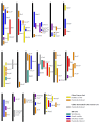Colitis-associated colon cancer: Is it in your genes?
- PMID: 26556996
- PMCID: PMC4631970
- DOI: 10.3748/wjg.v21.i41.11688
Colitis-associated colon cancer: Is it in your genes?
Abstract
Colitis-associated colorectal cancer (CA-CRC) is the cause of death in 10%-15% of inflammatory bowel disease (IBD) patients. CA-CRC results from the accumulation of mutations in intestinal epithelial cells and progresses through a well-characterized inflammation to dysplasia to carcinoma sequence. Quantitative estimates of overall CA-CRC risks are highly variable ranging from 2% to 40% depending on IBD severity, duration and location, with IBD duration being the most significant risk factor associated with CA-CRC development. Recently, studies have identified IBD patients with similar patterns of colonic inflammation, but that differ with respect to CA-CRC development, suggesting a role for additional non-inflammatory risk factors in CA-CRC development. One suggestion is that select IBD patients carry polymorphisms in various low penetrance disease susceptibility genes, which pre-dispose them to CA-CRC development, although these loci have proven difficult to identify in human genome-wide association studies. Mouse models of CA-CRC have provided a viable alternative for the discovery, validation and study of individual genes in CA-CRC pathology. In this review, we summarize the current CA-CRC literature with a strong focus on genetic pre-disposition and highlight an emerging role for mouse models in the search for CA-CRC risk alleles.
Keywords: Azoxymethane; Colitis-associated colorectal cancer; Dextran sulfate sodium; Forward genetics; Inflammatory bowel disease; Mouse models; Susceptibility genes.
Figures


References
-
- Aliment Pharmacol Ther. The Impact of Inflammatory Bowel Disease in Canada: 2012 Final Report and Recommendations; 2012.
-
- Loftus EV, Schoenfeld P, Sandborn WJ. The epidemiology and natural history of Crohn’s disease in population-based patient cohorts from North America: a systematic review. Aliment Pharmacol Ther. 2002;16:51–60. - PubMed
-
- O’Brien KD, Corkill CM. The specialist orthodontic practitioner. The 1989 survey. Br Dent J. 1990;168:471–475. - PubMed
-
- Cho J, Pastorino S, Zeng Q, Xu X, Johnson W, Vandenberg S, Verhaak R, Cherniack AD, Watanabe H, Dutt A, et al. Glioblastoma-derived epidermal growth factor receptor carboxyl-terminal deletion mutants are transforming and are sensitive to EGFR-directed therapies. Cancer Res. 2011;71:7587–7596. - PMC - PubMed
-
- Cosnes J, Gower-Rousseau C, Seksik P, Cortot A. Epidemiology and natural history of inflammatory bowel diseases. Gastroenterology. 2011;140:1785–1794. - PubMed
Publication types
MeSH terms
Grants and funding
LinkOut - more resources
Full Text Sources
Other Literature Sources

